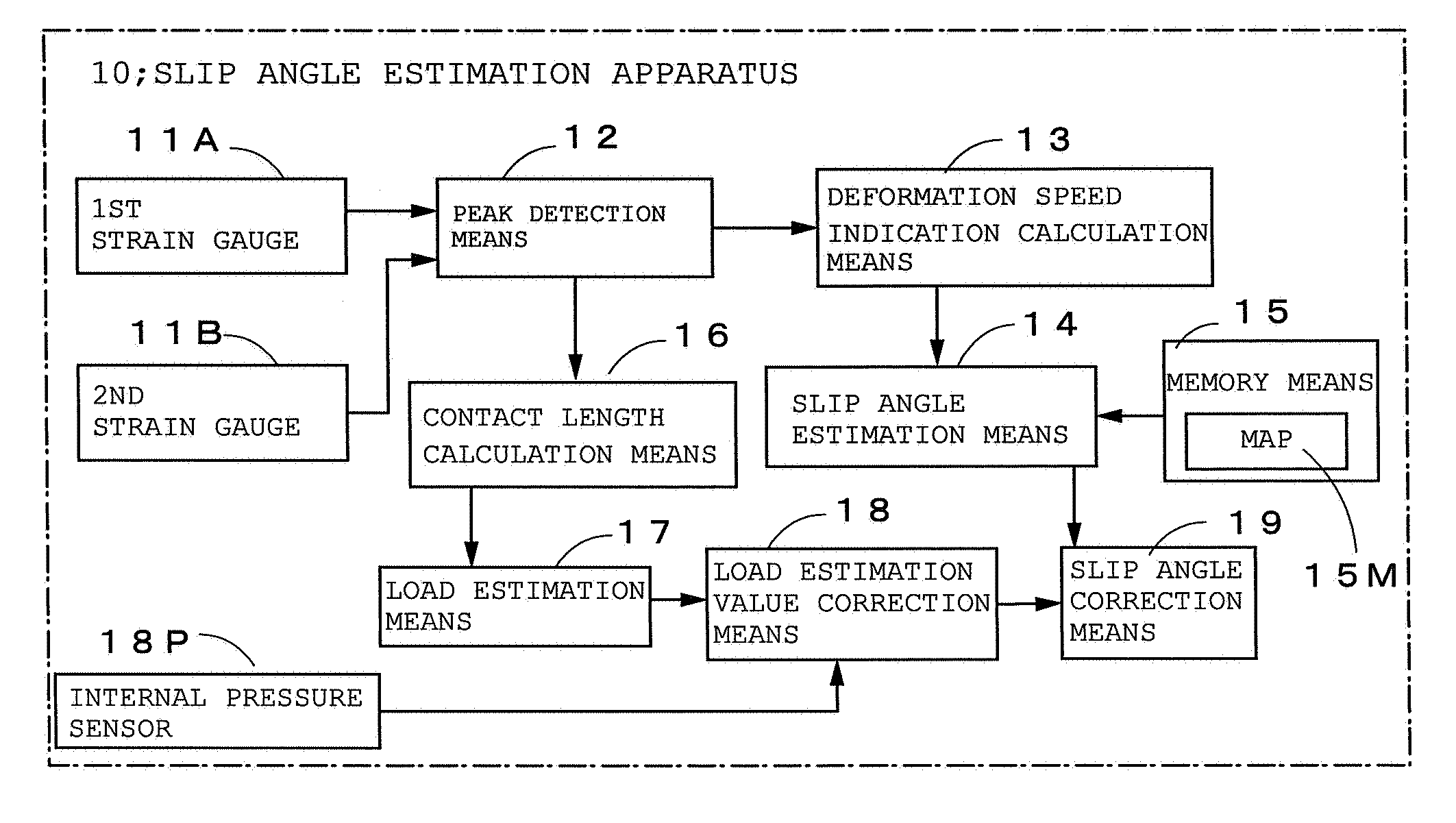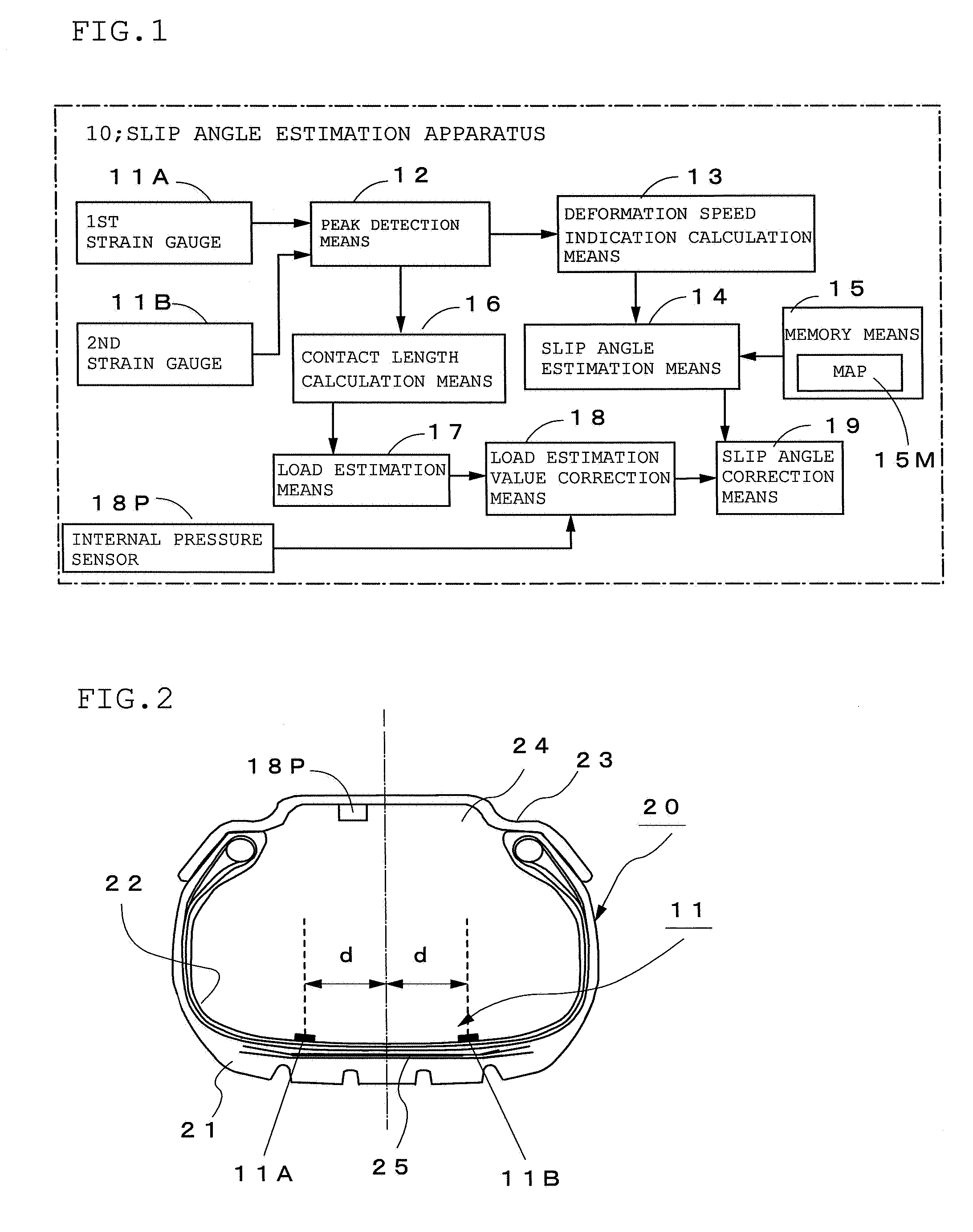Method for estimating tire slip angle and a tire with sensors mounted therein
a technology of tire slip angle and sensor, which is applied in the direction of instruments, braking systems, transportation and packaging, etc., can solve the problems of affecting detection performance, yaw rate, and complicated corrections, and achieve the effect of improving the accuracy of estimating the slip angl
- Summary
- Abstract
- Description
- Claims
- Application Information
AI Technical Summary
Benefits of technology
Problems solved by technology
Method used
Image
Examples
embodiment 1
Preferred Embodiment 1
[0034]FIG. 1 is a block diagram showing constitution of the slip angle estimation apparatus 10, and FIG. 2 is a schematic diagram of the tire 20 with sensors mounted therein. In each of those drawings, reference numerals 11A and 11B denote the 1st and the 2nd strain gauges, respectively, for measuring deformation amount of the inner liner portion 22 deformed by the input from road surface to the tire tread 21 and those strain gauges 11A and 11B are mounted on the liner portion 22 of the tire 20 on the vehicle body side and the outer side, respectively at the positions located equally spaced apart in a tire axial direction and symmetrically with respect to the center thereof. The first and second strain gauges 11A and 11B constitute the paired sensors 11 according to the present invention.
[0035]The reference numeral 12 denotes a peak detection means for obtaining the deformation speed waveform by differentiating the deformation waveform detected by the paired se...
example 1
[0043]The tire with size of 225 / 55R17 having the configuration as shown by FIG. 2 is put on an indoor test equipment for running on a belt shaped flat road, and the deformation speed of the tire tread was detected from the output of a single paired strain gauges mounted to the tire which the slip angle was changed in constant levels up to ±8° under a constant load. In the above measurement, the internal pressure of the tire was kept at 230 Pa and running speed was kept constant at 60 km / h and loading was changed in seven levels between 200 N˜1000 N.
The graph as shown by FIG. 6 is a deformation speed waveform with the slip angle of +8° added measured at the inner liner portion. The peak in the positive direction of the waveform corresponds to the deformation speed Vf at the time of entering into the leading edge and, in this connection, the output from the strain gauge 1 on the side of the slip angle input becomes large and the one on the opposite side becomes small. In contrast with...
embodiment 2
[0044]In the preferred Embodiment 1, based on the deformation speed waveform obtained from the deformation waveform measured by the paired sensors 11 the peak values of the deformation speeds Vf1 and Vf2 from respective sensors 11 occurring at the time of entering into the leading edge when the tire tread entering into the contact portion with the road surface are detected and upon assigning those peak values as respective deformation speed indications, the slip angle is estimated from the ratio of the foregoing deformation speed indications, i.e., R=(Vf1 / Vf2) . However, plural paired sensors can be employed so as to obtain respective deformation speed indications from the peak values of deformation speed detected through at least two paired sensors. Then, upon obtaining the bending speed of the tire as a whole (total bending speed of the tire) based on the indication of the deformation speed from each pair of sensors, estimation of the tire slip angle can be made based on the total...
PUM
 Login to View More
Login to View More Abstract
Description
Claims
Application Information
 Login to View More
Login to View More - R&D
- Intellectual Property
- Life Sciences
- Materials
- Tech Scout
- Unparalleled Data Quality
- Higher Quality Content
- 60% Fewer Hallucinations
Browse by: Latest US Patents, China's latest patents, Technical Efficacy Thesaurus, Application Domain, Technology Topic, Popular Technical Reports.
© 2025 PatSnap. All rights reserved.Legal|Privacy policy|Modern Slavery Act Transparency Statement|Sitemap|About US| Contact US: help@patsnap.com



